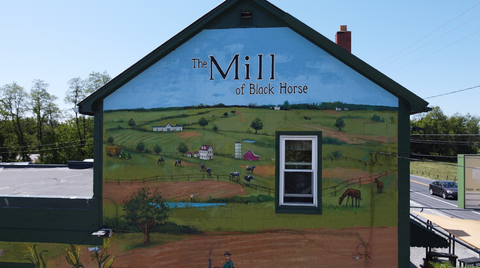The discussion and use of grazing muzzles can be fraught with varying opinions—much like the use of training aids such as spurs or whips. As with any tool, the effect can demonstrate a positive or negative result entirely based on how the tool is used. A spur, for example, when used as a teaching aid to encourage the understanding of a necessary cue, can be hugely helpful. It comes down to timing and the level of force used to communicate. That same spur can also be considered inhumane when it is not utilized correctly. This same concept applies to the grazing muzzle.
 When used properly, the grazing muzzle can be a huge asset in a horse owner’s bag of tricks for managing overweight or metabolic, at-risk horses and ponies. Regardless of where you currently stand on the use of grazing muzzles, we can all agree that managing a horse for health and safety is the #1 priority.
When used properly, the grazing muzzle can be a huge asset in a horse owner’s bag of tricks for managing overweight or metabolic, at-risk horses and ponies. Regardless of where you currently stand on the use of grazing muzzles, we can all agree that managing a horse for health and safety is the #1 priority. Horses were created to roam, graze, and participate in herd camaraderie. Their overall health and mental well-being are largely dependent on their ability to move about freely with other horses and consume many small, high-fiber meals throughout the day and night. When these things are restricted, problems can ensue.
The purpose of a grazing muzzle is to slow down consumption during grazing, thereby reducing the overall amount of sugars and starches ingested. While this is not a singular, foolproof way of managing sugar and starch intake, it is an excellent option to provide some restriction while still allowing the horse or pony to be turned out.
For overweight or metabolic, at-risk horses and ponies, turnout on fresh pasture can be catastrophic and even fatal if not managed correctly. The following are examples of at-risk animals:
- Overweight horses or those that tend to become overweight when turned out to pasture.
- Horses that struggle with metabolic conditions.
- Horses that are prone to metabolic conditions, including:
- Certain breeds genetically predisposed to metabolic disorders. Familiar breeds include Warmbloods, Quarter Horses, Morgans, Draft breeds, ponies in general, and breeds of color—such as Paints and Appaloosas—that have strong genetic ties to these breeds may exhibit more metabolic issues than hotter-blooded breeds.
- Breeds with faster metabolisms, such as Thoroughbreds and Arabians, typically have a lower risk of developing metabolic conditions. However, lower risk does not mean impossible—so it is still advised to be familiar with these issues and ways to help prevent problems.
- Certain illnesses, injuries, or other medical conditions that can lead to metabolic complications. High fevers, excessive stress, poor nutrition, and injuries that cause weight-bearing compensation on other limbs are some examples of how a metabolic emergency can begin.
- Gorging on feed or forage with a high NSC (Non-Structural Carbohydrate) content that is inconsistent with their normal sugar and starch intake can also trigger a metabolic upset.

The general rule of thumb is that a properly used grazing muzzle can restrict grazing consumption by around 30%. However, a variety of factors can skew that statistic both up and down. We all know horses that demonstrate Houdini-like escape capabilities. Some horses are very skilled at removing their grazing muzzles, while others have pasture-mates that serve as accomplices in freeing their friends. If the muzzle does not stay in place for the duration of time the horse or pony is turned out on pasture, it clearly has zero effect in reducing consumption.
On the other hand, some horses have a behavioral response to wearing the muzzle. In these cases, the animal may refuse to engage in normal activities, which can lead to further health complications. Consequently, it is highly advised that first-time muzzle wearers be introduced to the muzzle with care, consideration, and observation.
Some tips for acclimating a first-time muzzle wearer:

- Start with short wear periods and gradually increase time.
- Use only when exposed to pasture.
- Do not use in small, restricted areas like a stall, as this can lead to overwhelming, claustrophobic fear, increasing the risk of injury.
- Ensure the pasture is safe and free of objects that the muzzle could get caught on.
- Provide a large enough water trough for the horse to drink easily without accidentally banging the muzzle along the sides.
- Example: Replace a bucket with a hanging handle with a larger, handle-free receptacle, such as an actual water trough or a ground tub, to avoid panic and injury.
When fitting a muzzle, always ensure it is equipped with breakaway safety features. A properly fitting muzzle should allow for a two-finger width around the entire circumference. If you notice rub marks on the horse’s face, try a different size or shape, as rub marks indicate that the muzzle is either too small or the wrong fit. Many owners use additional padding, such as fleece or sheepskin, to help protect contact points. While this can be helpful, the situation must be monitored closely, as padding that becomes wet from rain, drinking, or sweat can actually cause more rubbing.

Finally, horses should not wear a muzzle for more than 10-12 hours a day. After that period, it may be best to bring the horse into a dry lot or stall. A slow-feed hay net can serve a similar purpose—restricting the rate of consumption while giving the horse a break from wearing the muzzle.
Following these guidelines can help make muzzle usage a beneficial tool in keeping overweight or metabolic horses and ponies safe and healthy!











